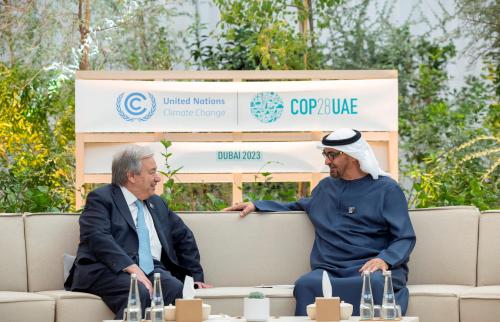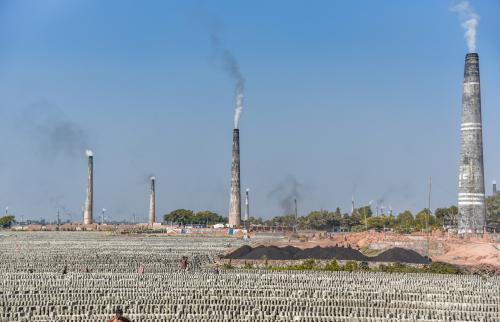In testimony before the Senate Foreign Relations Committee, Kenneth Lieberthal addressed the growing need for U.S.-China climate cooperation and how it is in the interest of both countries. Lieberthal’s testimony is below and video is also available.
Mr. Chairman and Members of the Foreign Relations Committee. Thank you for giving me the opportunity to comment on the critical issue of “Challenges and Opportunities for US-China Cooperation on Climate Change.”
China’s rate of growth of carbon emissions, especially since 2002, has been extremely steep, and pollution problems in China are rightly viewed as very sobering. Most Americans seem to believe that China is therefore ignoring its carbon emissions while pursuing all-out economic growth.
But the reality is that the leaders in Beijing have adopted serious measures to bring growth in carbon emissions under control, even as they try to maintain rapid overall expansion of GDP. To engage effectively with the Chinese and achieve the best outcomes on carbon emissions with them, it is important to have a realistic understanding both of the reasons their emissions are growing so rapidly and of the types of efforts they are making. It is critical that the US and China find ways to work as effectively as possible to reduce overall greenhouse gas emissions, and this requires reality-based approaches by each side toward the other.
First, why are China’s greenhouse gas emissions increasing so rapidly? Fundamental to the answer is that: 1. China’s economy is based overwhelmingly on coal; and 2. China retains many of the problems of a developing country.
Coal currently provides about 70% of China’s energy, and there is no serious alternative to coal for many decades to come. Without development and deployment of technology to reduce coal’s carbon footprint, the future looks grim for China’s carbon emissions. This provides a major area for potential US-China cooperation.
China always describes itself as a developing country, and it is more than half right. It makes sense to envision China as a group of relatively developed islands with a cumulative population of over 400 million people that are scattered around in a sea of over 800 million people who live very much in developing country conditions. The interaction between the developed areas and the developing regions is pervasive and affects every dimension of economic, social, and political life. Every Chinese leader views the developing part of the country as a constant and pressing reality.
One of the results of this developing country context is that China encounters more fundamental problems regarding human capital, infrastructure, social malaise, and technical capabilities than most of us appreciate. Put simply, China’s leaders lack the institutional and technical capabilities to achieve many of the improved energy outcomes that they seek. Indeed, the issue of capacity building is critically important for China’s future outcomes in the clean energy and climate change arenas and provides a major area of potential US-China cooperation.
Another reality of China’s developing country context is that Beijing is also focused on managing perhaps the greatest migratory flow in human history as urbanization proceeds on an almost unimaginable scale. Since 1992, nearly 200 million Chinese have shifted from rural to urban life, and the current pace of migration of about 15 million people per year moving into cities is likely to continue for another 15-20 years.
The resulting requirements for new power generation, building construction, transportation, education, health services, etc., means that, effectively, China has to build urban infrastructure and create urban jobs for a new, relatively poor city of 1.25 million people every month, and that will likely continue for the better part of the next two decades. The key industries that support the related infrastructure development – cement, steel, petrochemicals, power, and aluminum – have been among the fastest-growing industries in China over the past half decade and are also the most important sources of greenhouse gas emissions. In addition, as more Chinese achieve higher incomes, they want comfortable transportation, including private cars. Many also are upgrading their homes – making them larger and filling them with appliances. Carbon emissions growth reflects, therefore, extremely fundamental forces in China’s development.
China’s leaders also have competing environmental concerns, especially focused on water distribution and quality and on extremely severe air pollution, that divert serious resources from attacking the issue of carbon emissions.
In sum, while visits to Beijing or other major coastal areas may create the impression that China is a relatively developed country, the reality is far different. The underdeveloped parts of China have a population nearly three times the size of ours, and that population’s needs and capabilities inevitably shape major outcomes in China.
None of the above should be interpreted as indicating that controlling greenhouse gas emissions is not on Beijing’s priority list. That would be very far from the truth, as China sees itself as one of the countries most vulnerable to damage from climate change. In fact, when you look at the policies and programs already in place, they are very impressive – and they are constantly growing. Even the following short list of key official targets – every one backed up by substantial commitments of resources – suggests the reality that China is taking these issues very seriously. China is:
- Seeking a 20% reduction in energy intensity for all GDP during the 11th five-year plan, which covers 2006-2010.[1] According to Chinese authorities, total carbon emissions would decline by roughly a billion tons of CO2 over the course of the plan as against a “business as usual” (BAU) model, if this target were fully met. At present, progress toward the target is behind schedule, but the gap between targets and performance is closing.
- Adopting the target of having renewable fuels account for 10% of China’s total energy consumption by 2010 and 15% by 2020.[2] As part of this:
- Establishing major programs to improve technology in solar and wind power. China has rapidly become the world’s leading producer of solar panels, although solar power’s installed generating capacity is to increase to only 300,000 kW in 2010. For wind power, tax breaks and other forms of government support are already in place as of 2008. The installed generating capacity of wind power is to increase from 1.26 million kW in 2005 to 10 million kW in the year 2010.[3]
- Enhancing China’s hydropower generation (despite the fact that the country already has the greatest concentration of hydropower facilities in the world). The installed hydropower generating capacity is to increase from 117 million kW in 2005 to 190 million kW in 2010[4] and will provide 6.8%[5] of the country’s anticipated energy consumption in the latter year
- Taking serious measures to reduce the emissions from highly polluting power-generation facilities. Coal remains king in China, and about 70% of power still comes from coal-fired plants. Over the past five years China has built the equivalent of America’s entire coal power generation system. These plants will stay on line for another 30-50 years while 60% of U.S. coal-fired power plants will be over 50 years old by 2025. The technologies involved in generating power in these new plants are thus very important. Fortunately, China is building many of these plants to be relatively clean[6] and is investing in development and deployment of clean coal technologies.[7] Despite these measures, specific problems often result in emissions far above the level that would be anticipated from plant technology alone. This is the unintended result of economic pressures at the power plant level that lead many operators to purchase and burn low-quality coal that undermines the efficiency capabilities of the advanced technologies in their plants.[8]
- Aggressively expanding nuclear power capabilities, with a target of building nine new generators in the next two years and at least thirty over the coming decade. Nuclear is slated to provide 5% of China’s total installed power-generating capacity by 2020.[9] There have been recent suggestions that the nuclear output target has been raised from 40 GW to 70 GW by 2020.[10]
- Investing over 600 billion RMB ($88 billion) on ultra-high voltage transmission projects by 2020. The installed capacity of China’s clean energy will be increased to 579 billion kW when the smart grid is completed by 2020.[11]
The bottom line is that China faces enormous pressures via urbanization and other aspects of development to continue massive creation of infrastructure, it takes reduction of greenhouse gas emissions as against a BAU model extremely seriously, and it has more problems in terms of lack of capacity than is true for developed countries.
There are serious implications for the US and for Copenhagen in the above comments. These include:[12]
- There are numerous areas in which US-China cooperation on clean energy can be in both our interests. We have many complementary capabilities. But such cooperation has to be based on the trust that grows out of realistic understanding of each others actions, problems, worries, capabilities, and goals. That trust is not yet there.
- At Copenhagen, China should be pushed hard to accept targets for greenhouse gas emissions that require major efforts to achieve. Beijing should also accept full verification requirements, which include transparency, clear metrics, etc. But China will, in my judgment, not accept caps at this point. It does not see how it can possibly actually cap emissions growth, given the ongoing urbanization and other developments noted above, and Beijing does not accept international obligations that it does not think it is capable of meeting. Chinese quantitative obligations are, therefore, likely to focus on improvements in energy intensity per unit of GDP, perhaps bolstered by some sectoral requirements, along with targets on use of renewables. China cannot avoid an overall cap on carbon emissions indefinitely, but it is not in a position realistically to accept a cap at Copenhagen.
- The United States and China should work to develop a major clean energy partnership. Achieving such a partnership will provide new momentum to the Copenhagen effort. It will demonstrate that the US and China are serious about improving their records on clean energy. It inherently will also highlight that, despite the differences in principle that separate the industrialized from the developing countries over responsibilities for greenhouse gas emissions, the most important developed and most important developing country can find significant ways to work together. But a US-China clean energy partnership and the Copenhagen effort should be developed separately, as the negotiating framework for the latter is far more complicated than that for the former. Close linkage, therefore, may complicate both issues.
I hope the above comments are helpful and look forward to your questions. Thank you.
[1] “The Energy Development Plan for the 11th Five-Year Period.” the National Development and Reform Council (NDRC), Government of the People’s Republic of China, April 2007. Available at: http://www.ccchina.gov.cn/WebSite/CCChina/UpFile/File186.pdf
[2] “The Medium and Long-Term Development Plan for Renewable Energy,” the National Development and Reform Council (NDRC), Government of the Peoples’ Republic of China, August 2007. Available at: http://www.ccchina.gov.cn/WebSite/CCChina/UpFile/2007/20079583745145.pdf. China passed a renewable energy law in 2006. In 2007 renewables accounted for 8.5% of China’s energy production.
[3] “The Renewable Energy Development Plan for the 11th Five-Year Period,” NDRC, PRC. March 2008.
Available at: www.ccchina.gov.cn/WebSite/CCChina/UpFile/File186.pdf.
[4] “The Renewable Energy Development Plan for the 11th Five-year Period,” ibid.
[5] “The Energy Development Plan for the 11th Five-Year Period.”
[6] Government regulations now require that: new plants be synchronously equipped with flue gas desulfurization (FGD) technology before 2010; existing plants begin to be retrofitted with FGD technology before 2010; all plants meet SO2 requirements before 2015; and new plants set aside space for future flue gas denitrification equipment installations. New power-generation units are equipped with low-NOX burners, and many existing units have been retrofitted with this technology: Zhao, Lifeng and Gallagher, Kelly Sims, “Research, Development, Demonstration, and Early Development Policies for Advanced-Coal Technology in China,” Energy Policy, Vol. 35, 2007, 6467-6477.
[7] This includes, for example, substantial work on direct hydrogenation of coal, with production starting up in the Inner Mongolian Autonomous Region in 2008. Beijing is also focusing on coal gasification and is constructing 35 plants using this technique.
[8] Edward S. Steinfeld, Richard K. Lester, and Edward A. Cunningham, Greener Plants, Grayer Skies? A Report from the Front Lines of China’s Energy Sector (Cambridge, Mass.: China Energy Group, MIT Industrial Performance Center, August 2008).
[9] “The Nuclear Industry Development Plan for the 11th Five-Year Period,” the Commission of Science, Technology, and Industry for National Defense (COSTIND), the Peoples’ Republic of China, August 2006. Available at: http://www.caea.gov.cn/n602669/n602673/n602687/n607857/appendix/200741310370.doc
“China ups targeted nuclear power share from 4% to 5% for 2020,” Xinhua News, August 5, 2008. Available at: http://news.xinhuanet.com/english/2008-08/05/content_8967806.htm.
[10] China Daily, November 19, 2008: http://www.chinadaily.com.cn/bizchina/2008-11/06/content_7180851.htm.
[11] China Daily (May 29, 2009).
[12] For a fuller explanation of potential avenues of future US-China cooperation to address climate change, see: Kenneth Lieberthal and David Sandalow, Overcoming Obstacles to US-China Cooperation on Climate Change (Washington: The Brookings Institution John L. Thornton China Center, 2009), available in .pdf at brookings-edu-2023.go-vip.net .



Commentary
TestimonyChallenges and Opportunities for U.S.-China Cooperation on Climate Change
June 4, 2009